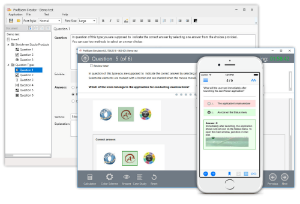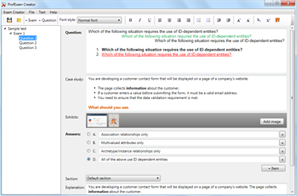File Info
| Exam | AWS Certified Cloud Practitioner |
| Number | CLF-C02 |
| File Name | Amazon.CLF-C02.VCEplus.2025-04-02.304q.vcex |
| Size | 319 KB |
| Posted | Apr 02, 2025 |
| Download | Amazon.CLF-C02.VCEplus.2025-04-02.304q.vcex |
How to open VCEX & EXAM Files?
Files with VCEX & EXAM extensions can be opened by ProfExam Simulator.
Coupon: MASTEREXAM
With discount: 20%
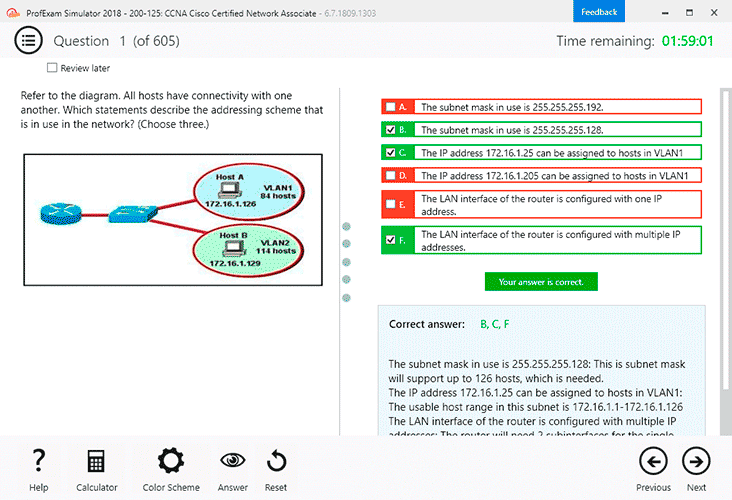

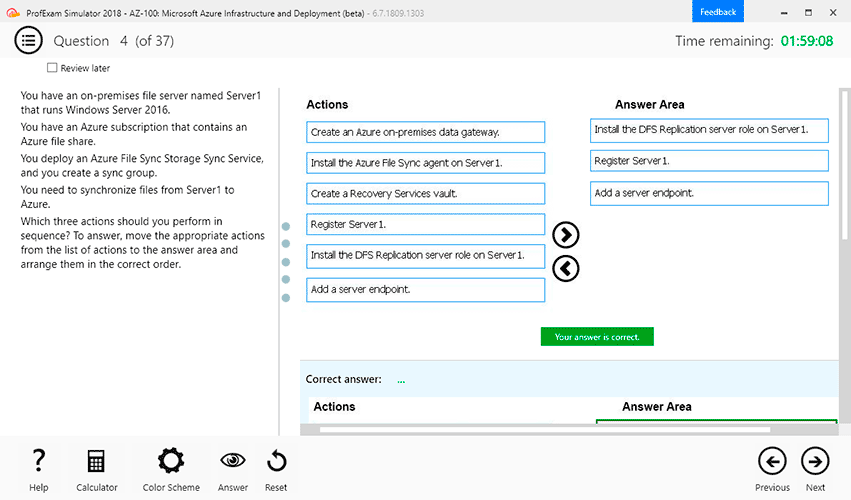
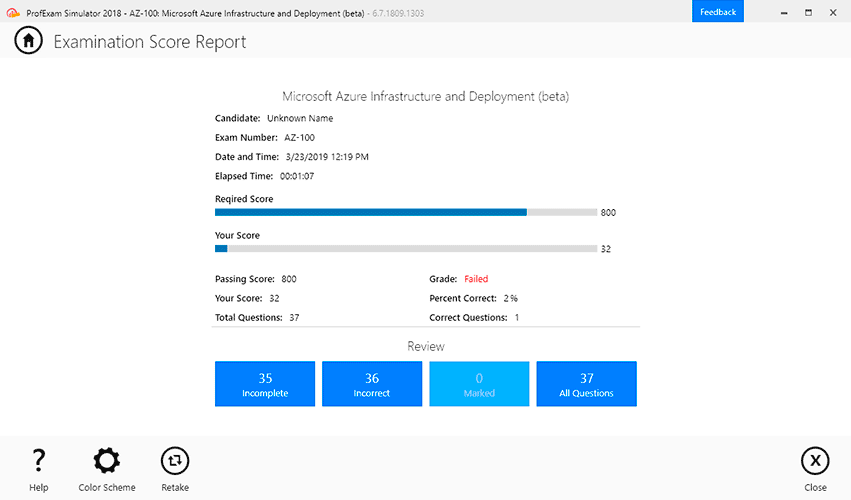
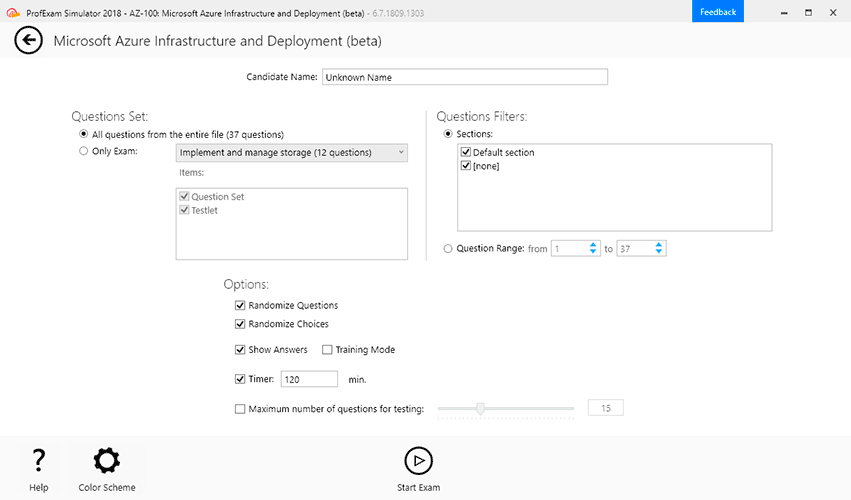

Demo Questions
Question 1
Which design principle is achieved by following the reliability pillar of the AWS Well-Architected Framework?
- Vertical scaling
- Manual failure recovery
- Testing recovery procedures
- Changing infrastructure manually
Correct answer: C
Explanation:
: Testing recovery procedures is the design principle that is achieved by following the reliability pillar of the AWS Well-Architected Framework. The reliability pillar focuses on the ability of a system to recover from failures and prevent disruptions. Testing recovery procedures helps to ensure that the system can handle different failure scenarios and restore normal operations as quickly as possible.Testing recovery procedures also helps to identify and mitigate any risks or gaps in the system design and implementation. For more information, see [Reliability Pillar] and [Testing for Reliability]. : Testing recovery procedures is the design principle that is achieved by following the reliability pillar of the AWS Well-Architected Framework. The reliability pillar focuses on the ability of a system to recover from failures and prevent disruptions. Testing recovery procedures helps to ensure that the system can handle different failure scenarios and restore normal operations as quickly as possible.
Testing recovery procedures also helps to identify and mitigate any risks or gaps in the system design and implementation. For more information, see [Reliability Pillar] and [Testing for Reliability].
Question 2
What is a benefit of moving to the AWS Cloud in terms of improving time to market?
- Decreased deployment speed
- Increased application security
- Increased business agility
- Increased backup capabilities
Correct answer: C
Explanation:
Increased business agility is a benefit of moving to the AWS Cloud in terms of improving time to market. Business agility refers to the ability of a company to adapt to changing customer needs, market conditions, and competitive pressures. Moving to the AWS Cloud enables business agility by providing faster access to resources, lower upfront costs, and greater scalability and flexibility. By using the AWS Cloud, companies can launch new products and services, experiment with new ideas, and respond to customer feedback more quickly and efficiently. For more information, see [Benefits of Cloud Computing] and [Business Agility]. Increased business agility is a benefit of moving to the AWS Cloud in terms of improving time to market. Business agility refers to the ability of a company to adapt to changing customer needs, market conditions, and competitive pressures. Moving to the AWS Cloud enables business agility by providing faster access to resources, lower upfront costs, and greater scalability and flexibility. By using the AWS Cloud, companies can launch new products and services, experiment with new ideas, and respond to customer feedback more quickly and efficiently. For more information, see [Benefits of Cloud Computing] and [Business Agility].
Question 3
A company wants high levels of detection and near-real-time (NRT) mitigation against large and sophisticated distributed denial of service (DDoS) attacks on applications running on AWS. Which AWS service should the company use?
- Amazon GuardDuty
- Amazon Inspector
- AWS Shield Advanced
- Amazon Macie
Correct answer: C
Explanation:
AWS Shield Advanced is a service that provides high levels of detection and near-real-time (NRT) mitigation against large and sophisticated distributed denial of service (DDoS) attacks on applications running on AWS. AWS Shield Advanced also provides you with 24x7 access to the AWS DDoS Response Team (DRT) and protection against DDoS attacks of any size or duration1. Amazon GuardDuty is a service that provides threat detection for your AWS accounts and workloads, but it does not offer DDoS protection3. Amazon Inspector is a service that helps you improve the security and compliance of your applications deployed on AWS by automatically assessing them for vulnerabilities and deviations from best practices. Amazon Macie is a service that uses machine learning and pattern matching to discover and protect your sensitive data in AWS. AWS Shield Advanced is a service that provides high levels of detection and near-real-time (NRT) mitigation against large and sophisticated distributed denial of service (DDoS) attacks on applications running on AWS. AWS Shield Advanced also provides you with 24x7 access to the AWS DDoS Response Team (DRT) and protection against DDoS attacks of any size or duration1. Amazon GuardDuty is a service that provides threat detection for your AWS accounts and workloads, but it does not offer DDoS protection3. Amazon Inspector is a service that helps you improve the security and compliance of your applications deployed on AWS by automatically assessing them for vulnerabilities and deviations from best practices. Amazon Macie is a service that uses machine learning and pattern matching to discover and protect your sensitive data in AWS.
Question 4
A company needs to control inbound and outbound traffic for an Amazon EC2 instance.
Which AWS service or feature can the company associate with the EC2 instance to meet this requirement?
- Network ACL
- Security group
- AWS WAF
- VPC route tables
Correct answer: B
Explanation:
A security group is a virtual firewall that can be associated with an Amazon EC2 instance to control the inbound and outbound traffic for the instance. You can specify which protocols, ports, and source or destination IP ranges are allowed or denied by the security group. A network ACL is a stateless filter that can be associated with a subnet to control the traffic to and from the subnet, but it is not associated with an EC2 instance4. AWS WAF is a web application firewall that helps protect your web applications or APIs against common web exploits that may affect availability, compromise security, or consume excessive resources. VPC route tables are used to determine where network traffic is directed within a VPC or to an internet gateway, virtual private gateway, NAT device, VPC peering connection, or VPC endpoint. A security group is a virtual firewall that can be associated with an Amazon EC2 instance to control the inbound and outbound traffic for the instance. You can specify which protocols, ports, and source or destination IP ranges are allowed or denied by the security group. A network ACL is a stateless filter that can be associated with a subnet to control the traffic to and from the subnet, but it is not associated with an EC2 instance4. AWS WAF is a web application firewall that helps protect your web applications or APIs against common web exploits that may affect availability, compromise security, or consume excessive resources. VPC route tables are used to determine where network traffic is directed within a VPC or to an internet gateway, virtual private gateway, NAT device, VPC peering connection, or VPC endpoint.
Question 5
A company is expecting a short-term spike in internet traffic for its application. During the traffic increase, the application cannot be interrupted. The company also needs to minimize cost and maximize flexibility.
A company needs to use a serverless interactive query service to analyze data in Amazon S3. The query service must support standard SQL.
Which AWS service will meet these requirements?
- Amazon Redshift
- AWS Glue
- Amazon Athena
- Amazon Kinesis Data Streams
Correct answer: C
Explanation:
Amazon Athena is a serverless interactive query service that makes it easy to analyze data in Amazon S3 using standard SQL. Athena is ideal for quick, ad-hoc querying but it can also handle complex analysis, including large joins, window functions, and arrays. Athena scales automatically-executing queries in parallel-so results are fast, even with large datasets and complex queries. Amazon Redshift is a fully managed, petabyte-scale data warehouse service that can run complex analytic queries against structured and semi-structured data using standard SQL. However, it is not a serverless service and requires provisioning and managing clusters of nodes. AWS Glue is a fully managed extract, transform, and load (ETL) service that makes it easy to prepare and load your data for analytics. However, it is not a query service and does not support standard SQL. Amazon Kinesis Data Streams is a service that enables you to build custom applications that process or analyze streaming data for specialized needs. However, it is not a query service and does not support standard SQL. Amazon Athena is a serverless interactive query service that makes it easy to analyze data in Amazon S3 using standard SQL. Athena is ideal for quick, ad-hoc querying but it can also handle complex analysis, including large joins, window functions, and arrays. Athena scales automatically-executing queries in parallel-so results are fast, even with large datasets and complex queries. Amazon Redshift is a fully managed, petabyte-scale data warehouse service that can run complex analytic queries against structured and semi-structured data using standard SQL. However, it is not a serverless service and requires provisioning and managing clusters of nodes. AWS Glue is a fully managed extract, transform, and load (ETL) service that makes it easy to prepare and load your data for analytics. However, it is not a query service and does not support standard SQL. Amazon Kinesis Data Streams is a service that enables you to build custom applications that process or analyze streaming data for specialized needs. However, it is not a query service and does not support standard SQL.
Question 6
A company needs to run a workload for several batch image rendering applications. It is acceptable for the workload to experience downtime.
Which Amazon EC2 pricing model would be MOST cost-effective in this situation?
- On-Demand Instances
- Reserved Instances
- Dedicated Instances
- Spot Instances
Correct answer: D
Explanation:
Amazon EC2 Spot Instances are instances that use spare EC2 capacity that is available at up to a 90%discount compared to On-Demand prices. You can use Spot Instances for various stateless, fault-tolerant, or flexible applications such as big data, containerized workloads, high-performance computing (HPC), and test & development workloads. Spot Instances are ideal for workloads that can be interrupted, such as batch image rendering applications1. On-Demand Instances are instances that let you pay for compute capacity by the hour or second (minimum of 60 seconds) with no longterm commitments. This frees you from the costs and complexities of planning, purchasing, and maintaining hardware and transforms what are commonly large fixed costs into much smaller variable costs2. Reserved Instances are instances that provide you with a significant discount (up to 75%) compared to On-Demand Instance pricing. In exchange, you select a term and make an upfront payment to reserve a certain amount of compute capacity for that term3. Dedicated Instances are instances that run in a VPC on hardware that's dedicated to a single customer. Your Dedicated Instances are physically isolated at the host hardware level from instances that belong to other AWS accounts4. Amazon EC2 Spot Instances are instances that use spare EC2 capacity that is available at up to a 90%discount compared to On-Demand prices. You can use Spot Instances for various stateless, fault-tolerant, or flexible applications such as big data, containerized workloads, high-performance computing (HPC), and test & development workloads. Spot Instances are ideal for workloads that can be interrupted, such as batch image rendering applications1. On-Demand Instances are instances that let you pay for compute capacity by the hour or second (minimum of 60 seconds) with no longterm commitments. This frees you from the costs and complexities of planning, purchasing, and maintaining hardware and transforms what are commonly large fixed costs into much smaller variable costs2. Reserved Instances are instances that provide you with a significant discount (up to 75%) compared to On-Demand Instance pricing. In exchange, you select a term and make an upfront payment to reserve a certain amount of compute capacity for that term3. Dedicated Instances are instances that run in a VPC on hardware that's dedicated to a single customer. Your Dedicated Instances are physically isolated at the host hardware level from instances that belong to other AWS accounts4.
Question 7
A company has an application that runs periodically in an on-premises environment. The application runs for a few hours most days, but runs for 8 hours a day for a week at the end of each month. Which AWS service or feature should be used to host the application in the AWS Cloud?
- Amazon EC2 Standard Reserved Instances
- Amazon EC2 On-Demand Instances
- AWS Wavelength
- Application Load Balancer
Correct answer: B
Explanation:
Amazon EC2 On-Demand Instances are instances that let you pay for compute capacity by the hour or second (minimum of 60 seconds) with no long-term commitments. This frees you from the costs and complexities of planning, purchasing, and maintaining hardware and transforms what are commonly large fixed costs into much smaller variable costs. On-Demand Instances are suitable for applications with short-term, irregular, or unpredictable workloads that cannot be interrupted, such as periodic applications that run for a few hours most days, but run for 8 hours a day for a week at the end of each month2. Amazon EC2 Standard Reserved Instances are instances that provide you with a significant discount (up to 75%) compared to On-Demand Instance pricing. In exchange, you select a term and make an upfront payment to reserve a certain amount of compute capacity for that term. Reserved Instances are suitable for applications with steady state or predictable usage that require reserved capacity3. AWS Wavelength is a service that enables developers to build applications that deliver ultra-low latency to mobile devices and users by deploying AWS compute and storage at the edge of the 5G network. Wavelength is suitable for applications that require single-digit millisecond latencies, such as game and live video streaming, machine learning inference at the edge, and augmented and virtual reality (AR/VR). Application Load Balancer is a service that operates at the request level (layer 7) and distributes incoming application traffic across multiple targets, such as EC2 instances, containers, Lambda functions, and IP addresses. Application Load Balancer is suitable for applications that need advanced routing capabilities, such as microservices or container-based architectures. Amazon EC2 On-Demand Instances are instances that let you pay for compute capacity by the hour or second (minimum of 60 seconds) with no long-term commitments. This frees you from the costs and complexities of planning, purchasing, and maintaining hardware and transforms what are commonly large fixed costs into much smaller variable costs. On-Demand Instances are suitable for applications with short-term, irregular, or unpredictable workloads that cannot be interrupted, such as periodic applications that run for a few hours most days, but run for 8 hours a day for a week at the end of each month2. Amazon EC2 Standard Reserved Instances are instances that provide you with a significant discount (up to 75%) compared to On-Demand Instance pricing. In exchange, you select a term and make an upfront payment to reserve a certain amount of compute capacity for that term. Reserved Instances are suitable for applications with steady state or predictable usage that require reserved capacity3. AWS Wavelength is a service that enables developers to build applications that deliver ultra-low latency to mobile devices and users by deploying AWS compute and storage at the edge of the 5G network. Wavelength is suitable for applications that require single-digit millisecond latencies, such as game and live video streaming, machine learning inference at the edge, and augmented and virtual reality (AR/VR). Application Load Balancer is a service that operates at the request level (layer 7) and distributes incoming application traffic across multiple targets, such as EC2 instances, containers, Lambda functions, and IP addresses. Application Load Balancer is suitable for applications that need advanced routing capabilities, such as microservices or container-based architectures.
Question 8
A company is planning to migrate to the AWS Cloud. The company is conducting organizational transformation and wants to become more responsive to customer inquiries and feedback.
Which tasks should the company perform to meet these requirements, according to the AWS Cloud Adoption Framework (AWS CAF)? (Select TWO.)
- Realign teams to focus on products and value streams.
- Create new value propositions with new products and services.
- Use agile methods to rapidly iterate and evolve.
- Use a new data and analytics platform to create actionable insights.
- Migrate and modernize legacy infrastructure.
Correct answer: AC
Explanation:
Realigning teams to focus on products and value streams, and using agile methods to rapidly iterate and evolve are tasks that the company should perform to meet the requirements of becoming more responsive to customer inquiries and feedback, according to the AWS Cloud Adoption Framework (AWS CAF). AWS CAF organizes guidance into six areas of focus, called perspectives: business, people, governance, platform, security, and operations.Each perspective is divided into capabilities, which describe the skills and processes to execute the transition effectively. The people perspective helps you prepare your organization for cloud adoption, and includes capabilities such as organizational change management, staff skills and readiness, and organizational alignment. The business perspective helps you align IT strategy with business strategy, and includes capabilities such as business case development, value proposition, and product ownership. Creating new value propositions with new products and services is a task that belongs to the business perspective, but it is not directly related to the requirement of becoming more responsive to customer inquiries and feedback. Using a new data and analytics platform to create actionable insights is a task that belongs to the platform perspective, which helps you design, implement, and optimize the architecture of the AWS environment. However, it is also not directly related to the requirement of becoming more responsive to customer inquiries and feedback. Migrating and modernizing legacy infrastructure is a task that belongs to the operations perspective, which helps you enable, run, use, operate, and recover IT workloads to the level agreed upon with your business stakeholders. However, it is also not directly related to the requirement of becoming more responsive to customer inquiries and feedback. Realigning teams to focus on products and value streams, and using agile methods to rapidly iterate and evolve are tasks that the company should perform to meet the requirements of becoming more responsive to customer inquiries and feedback, according to the AWS Cloud Adoption Framework (AWS CAF). AWS CAF organizes guidance into six areas of focus, called perspectives: business, people, governance, platform, security, and operations.
Each perspective is divided into capabilities, which describe the skills and processes to execute the transition effectively. The people perspective helps you prepare your organization for cloud adoption, and includes capabilities such as organizational change management, staff skills and readiness, and organizational alignment. The business perspective helps you align IT strategy with business strategy, and includes capabilities such as business case development, value proposition, and product ownership. Creating new value propositions with new products and services is a task that belongs to the business perspective, but it is not directly related to the requirement of becoming more responsive to customer inquiries and feedback. Using a new data and analytics platform to create actionable insights is a task that belongs to the platform perspective, which helps you design, implement, and optimize the architecture of the AWS environment. However, it is also not directly related to the requirement of becoming more responsive to customer inquiries and feedback. Migrating and modernizing legacy infrastructure is a task that belongs to the operations perspective, which helps you enable, run, use, operate, and recover IT workloads to the level agreed upon with your business stakeholders. However, it is also not directly related to the requirement of becoming more responsive to customer inquiries and feedback.
Question 9
In which of the following AWS services should database credentials be stored for maximum security?
- AWS Identity and Access Management (1AM)
- AWS Secrets Manager
- Amazon S3
- AWS Key Management Service (AWS KMS)
Correct answer: B
Explanation:
AWS Secrets Manager is the AWS service where database credentials should be stored for maximum security. AWS Secrets Manager helps to protect the secrets, such as database credentials, passwords, API keys, and tokens, that are used to access applications, services, and resources. AWS Secrets Manager enables secure storage, encryption, rotation, and retrieval of the secrets. AWS Secrets Manager also integrates with other AWS services, such as AWS Identity and Access Management (IAM), AWS Key Management Service (AWS KMS), and AWS Lambda. For more information, see [What is AWS Secrets Manager?] and [Getting Started with AWS SecretsManager]. AWS Secrets Manager is the AWS service where database credentials should be stored for maximum security. AWS Secrets Manager helps to protect the secrets, such as database credentials, passwords, API keys, and tokens, that are used to access applications, services, and resources. AWS Secrets Manager enables secure storage, encryption, rotation, and retrieval of the secrets. AWS Secrets Manager also integrates with other AWS services, such as AWS Identity and Access Management (IAM), AWS Key Management Service (AWS KMS), and AWS Lambda. For more information, see [What is AWS Secrets Manager?] and [Getting Started with AWS Secrets
Manager].
Question 10
A company needs to configure rules to identify threats and protect applications from malicious network access.
Which AWS service should the company use to meet these requirements?
- AWS Identity and Access Management (1AM)
- Amazon QuickSight
- AWS WAF
- Amazon Detective
Correct answer: C
Explanation:
AWS WAF is the AWS service that the company should use to configure rules to identify threats and protect applications from malicious network access. AWS WAF is a web application firewall that helps to filter, monitor, and block malicious web requests based on customizable rules. AWS WAF can be integrated with other AWS services, such as Amazon CloudFront, Amazon API Gateway, and Application Load Balancer. For more information, see What is AWS WAF? and How AWS WAF Works. AWS WAF is the AWS service that the company should use to configure rules to identify threats and protect applications from malicious network access. AWS WAF is a web application firewall that helps to filter, monitor, and block malicious web requests based on customizable rules. AWS WAF can be integrated with other AWS services, such as Amazon CloudFront, Amazon API Gateway, and Application Load Balancer. For more information, see What is AWS WAF? and How AWS WAF Works.
Question 11
What does "security of the cloud" refer to in the AWS shared responsibility model?
- Availability of AWS services such as Amazon EC2
- Security of the cloud infrastructure that runs all the AWS services
- Implementation of password policies for 1AM users
- Security of customer environments by using AWS Network Firewall partners
Correct answer: B
Explanation:
Security of the cloud refers to the security of the cloud infrastructure that runs all the AWS services.This includes the hardware, software, networking, and facilities that AWS operates and manages.AWS is responsible for protecting the security of the cloud as part of the AWS shared responsibility model. Availability of AWS services such as Amazon EC2 refers to the ability of the services to be up and running and to meet the expected performance. Availability is part of the reliability pillar of the AWS Well-Architected Framework and is a shared responsibility between AWS and the customer .Implementation of password policies for IAM users refers to the security of the customer data and applications in the cloud. This includes the configuration and management of IAM user permissions, encryption keys, security group rules, network ACLs, and other aspects of access management. The customer is responsible for protecting the security in the cloud as part of the AWS shared responsibility model. Security of customer environments by using AWS Network Firewall partners refers to the security of the customer data and applications in the cloud. AWS Network Firewall is a managed service that provides network protection for Amazon VPCs. It allows customers to use AWS Marketplace partners to implement firewall rules and policies. The customer is responsible for protecting the security in the cloud as part of the AWS shared responsibility model . Security of the cloud refers to the security of the cloud infrastructure that runs all the AWS services.
This includes the hardware, software, networking, and facilities that AWS operates and manages.
AWS is responsible for protecting the security of the cloud as part of the AWS shared responsibility model. Availability of AWS services such as Amazon EC2 refers to the ability of the services to be up and running and to meet the expected performance. Availability is part of the reliability pillar of the AWS Well-Architected Framework and is a shared responsibility between AWS and the customer .
Implementation of password policies for IAM users refers to the security of the customer data and applications in the cloud. This includes the configuration and management of IAM user permissions, encryption keys, security group rules, network ACLs, and other aspects of access management. The customer is responsible for protecting the security in the cloud as part of the AWS shared responsibility model. Security of customer environments by using AWS Network Firewall partners refers to the security of the customer data and applications in the cloud. AWS Network Firewall is a managed service that provides network protection for Amazon VPCs. It allows customers to use AWS Marketplace partners to implement firewall rules and policies. The customer is responsible for protecting the security in the cloud as part of the AWS shared responsibility model .
